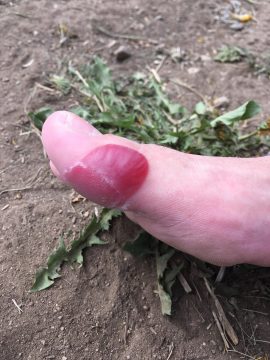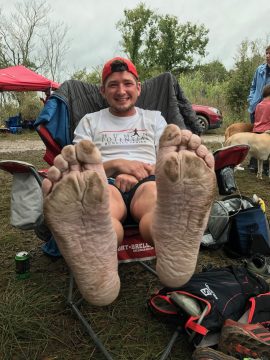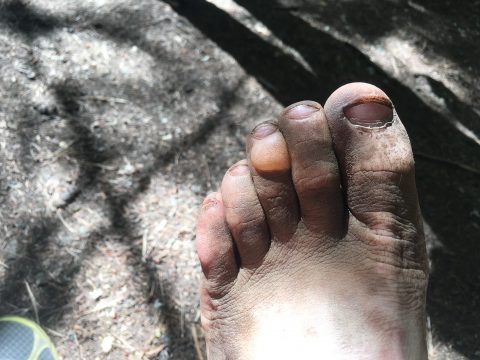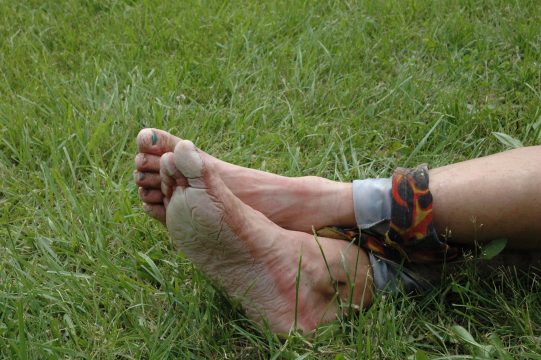By HPRS Staff Columnist Christopher Mellott
and HPRS Race Director Sherpa John Lacroix
This article is a collaboration between to two authors, Chris and Sherpa John. Chris’s contributions will be in black, while Sherpa’s will be in a slightly lighter color. They offer the following based on their own personal experiences in dealing with their feet for ultra distance events. We hope you find it fruitful.
Chris: The odds are probably good that if you are preparing to run your first ultra or have already run an ultra, you have spent far more time researching feet than you care to admit. You probably saw hundreds of images of hideous destroyed feet. Often these vomit inducing snapshots are accompanied with a caption along the lines of “you know you are a real runner when your feet look like this” or “I am so tough that nothing can stop me” or some other half witted comment. That was my experience as I crossed the threshold into the world of distance running.
Based on the information I had researched I was fearful that I would have three black toenails, another one missing, blisters the size of Ohio, and foot pad maceration like the Marianas Trench. I was terrified of what my feet would look like but also based on my searching of the internet it felt like terrible feet were a badge of honor to be praised for. A visual reminder of a person’s capacity for suffering. I was confident my feet were going to be terrible, I was never going to be able to wear sandals again, and that there was nothing I was able to do the halt the progression of it.
Turns out that wasn’t the case. My feet haven’t been destroyed, the few blisters I have managed to have are closer to the size of a dime than Ohio, and in my five years of running every day, I have only lost one toenail which was caused when I tripped on a rock at Badger Mountain 50 Miler.
Taking care of ourselves is an essential part of ultrarunning and taking care of our feet is no exception. We can avoid many of the common feet problems that runners experience with the right gear for us and paying attention to our feet.
 SOCKS
SOCKS
Chris: It is easy to think that a comfortable pair of socks is all you need, and maybe that’s true, but for the majority of us, we will probably need some good socks. I would suggest trying out a few types to find what works best for you. Courtney Dauwalter and Michael Wardian, both incredible ultrarunners, swear by Injinji Socks. The toe socks mean that the toes are not in contact with each other which may limit some blisters because of the lack of friction. In my experience toe socks have been great and I have ran three ultras in them with one blister between the three races.
I have a couple pairs of Swiftwick socks that I have done another ultra, a few marathons and numerous long runs, in. The moisture wicking and compression of the socks keep my feet feeling happy for many miles. These socks have lasted the test of time and are older than I care to admit.
I tried Drymax Socks because I had a coupon and decided to take a gamble on adding another sock brand to my repertoire even with the success of the other two brands. I was sure glad I did. I ran a race in the rain in the lush vegetation of Mount Spokane in October and my feet, even after landing in some snow and water, were comfortable, and I was able to avoid my feet pruning like a raisin in the sun.
For any runner, there is a certain point where all the research and all the articles you read about socks are excellent, but ultimately you have to decide what works best for you. I suggest asking your friends and other runners what socks they like to run in and then get a pair and try them out in different conditions. Find the socks that keep your feet happy, comfortable and most importantly healthy. I will let you know that some runners can run in cheap socks from Target, but most probably run in socks they look at in the store and say “They want how much for a pair of socks?!” I have paid more than I care to share on socks, but every time I get out miles onto the trail and my feet are happy I know that investment in the health of my feet is totally worth it.
Sherpa: Every time I walk into one of the local running stores, I get a good chuckle at just how many sock brands are out there to choose from. Like anything else in our running culture, we now have consumer overload. There is literally a type of sock, a brand of sock, for every kind of adventure. It can be an ominous task trying to narrow down the sock that will work for you. Simply trying socks on, with your favorite pair of running shoes, is not enough. Your socks need to be put to the test. You need to run them through the gambit of situations and conditions you’ll be looking for them to get you through, in order to ascertain which pair is indeed the right pair.
The first and most important mantra that I feel you need to subscribe to is, “Cotton Kills.” Do NOT wear cotton socks for running. They are not designed to withstand the kind of punishment you’re sure to put them through. They are not moisture whicking, they are moisture absorbing. They are not anti-bacterial, or anti-microbial. They are not comfortable, I don’t care what anybody says.
I have tried Injinji Toe socks in the past, but find that there are some design flaws with toe socks. The glaringly obvious flaw is that not all toes are the same. There are a variety of toe lengths out there, that will render toe socks useless when someone with the far too lengthy 2nd toe, can’t get the sock on their foot right. My feet and toes tend to be a little fat, so Injinji’s don’t fit me well. They feel more like a compression sock and pinch the spaces between my toes. I’m not about to be stubborn and try to make a sock work, that simply doesn’t.
I have tried a variety of sock brands over the years. As a race director I get a lot of sock samples sent to me by companies wanting me to try their products, with the hopes that I’ll buy pairs for you. Not all socks are alike. The two best brands I have ever worn are Darn Tough socks from Vermont and Balega. I sweat by both of these brands, and will be hard pressed to run in a brand different than these two again.
 On days when I know my feet are going to get wet, or be wet from the outset, I tend to steer towards a hearty pair of Drymax socks, or one of the thicker pair of wool socks made by Darn Tough. I’m far less interested if a pair of shoes has gore-tex or some other kind of waterproofing scheme.. As I am in choosing the right socks. Having the right socks, trumps having the perfect shoes, in my opinion. Your socks are you first line of defense, and offense.
On days when I know my feet are going to get wet, or be wet from the outset, I tend to steer towards a hearty pair of Drymax socks, or one of the thicker pair of wool socks made by Darn Tough. I’m far less interested if a pair of shoes has gore-tex or some other kind of waterproofing scheme.. As I am in choosing the right socks. Having the right socks, trumps having the perfect shoes, in my opinion. Your socks are you first line of defense, and offense.
SHOES
Chris: Everybody has an opinion on running shoes, and apparently, everybody on Facebook in any running group is an expert on running shoes and wants to tell you why ______ is the greatest running shoe ever and why ______ is the devil reincarnate.
First of all, the people who proclaim that “X” brand is the greatest are the people you should probably ignore. Finding the right shoe is like finding the right car. There are hundreds of options but only a few that will meet your needs. Do you need a lifted jeep with a giant rock crawling tires and a winch, if all you are doing is commuting to work? Probably not. Same as you probably don’t need the gnarliest trail shoes with waterproofing and lugs the size of Nuun tablets if you are only running a few miles on the sidewalks around the neighborhood.
For those that don’t have a favorite pair of shoes, I suggest going to a a local running store like RNK Running and Walking or Runner’s High and have them evaluate how you run and listen to their recommendations for shoes. Give the associate as much information about how you run and what you are hoping to run (trail, roads, or ice) as possible so they can give you options. If you are running long races you may want to think about getting shoes a half size bigger so your feet have room to swell.
Once you pick a pair of shoes that might work for you the next part is easy. GO RUN, try them out, and test the shoes in your favorite places. Do your shoes bring you joy? Do you feel like a fucking mountain goat going up and racing down? Find that shoe that does all that for you. Find the shoe that works best for you regardless of color, of reviews, or anything else. Not every shoe is going to work for every runner so find the one that works for you. I suggest sticking with the shoe that you feel secure and comfortable in. For me it’s the Hoka One One Speedgoat 2 for trails. For others there is nothing but hatred for the shoes especially the colors but I don’t care because the shoe just works for me, and I know it works for me because I tried seven other models of trail shoes including other Hoka trail shoes before I landed on these as my go-to trail shoe.
I like to know what other people are using. I like to know what shoes, or gear my friends are wearing and what elite runners are gravitating towards and testing those to see if I love them. I always want as much information as possible. If you have similar wonders or just mildlycurious what runners are using as their sock or shoe of choice for a big race, Western States does a survey of the runners about the gear their runners are using and published that information here at https://www.wser.org/2018/07/05/2018-runner-survey-results/
Once you got the socks, you got the shoes, and your feet are feeling good you might be set. If you find that you are still having trouble with blisters you may want to try some other things. I use Squirrel’s Nut Butter between my two biggest toes to keep them feeling good while running. You can use a lubricant where you get hot spots on your feet. If you are running a HPRS race then you will have access to Trail Toes.
Sherpa: I agree with pretty much everything Chris has shared above. With a few caveats and foods for though.
I highly recommend going to a running shoe store and having a gait analysis done by one of the sales associates. However, I would keep in mind that most of the sales associates you’ll meet at a running shoe store are not: athletic trainers, podiatrists, exercise physiologists, physical therapists.. Or have any real medical knowledge beyond what they learned in a brief nightly training on “how to do a gait analysis.” TRUST ME.. I’ve worked at The Boulder Running Company and was given a crash course on how to do a gait analysis. Even with the brief informal training, I can tell you.. I’m the last friggin’ person who should have been doing gait analysis on folks and making a solid shoe recommendation. This happens far more often than you think. So be wise.. While we both recommend the gait analysis, I also recommend going to a few different stores and seeing if you keep getting the same results. Then search for your shoe.
 Choose the shoe that fits. I do not subscribe to the “half size larger” mentality as it can leave far too much wiggle room if your foot never swells. I’m also a former soccer player and like tight fitting shoes. Keep in mind that, the more wiggle room you have in the shoe, the more opportunity you have in acquiring a blister. If the shoe fits.. Wear it.
Choose the shoe that fits. I do not subscribe to the “half size larger” mentality as it can leave far too much wiggle room if your foot never swells. I’m also a former soccer player and like tight fitting shoes. Keep in mind that, the more wiggle room you have in the shoe, the more opportunity you have in acquiring a blister. If the shoe fits.. Wear it.
Stay away from shoes that offer gore-tex or some other kind of water proofing material. No matter what, water is going to get in to your shoe. Let me say that again.. Gore-tex, eVent, waterproofing of any kind.. Water is still going to get in to your shoe. The difference is, that if you have one of these waterproofing materials or chemicals on the shoe, once the water gets in, it’s not coming out. You’ve just created a pretty baller petri dish for bacterial growth, or a swimming pool for your feet to breast stroke in. I tend to only use Gore-tex or waterproofed shoes when I intend to run in the snow. It works as a vapor barrier and keeps the warmth in. “So what do I wear for running in the rain or snow if not a gore-tex shoe?” Again, start with your socks. Wear a thicker pair of wool socks, and your feet will stay warmer even when wet.
No.. you don’t need the latest pair of Hoka’s to be an ultra runner. Different strokes for different folks. Since I started running in 2004, I have worn shoes made by Asics, Loco, The North Face, Salomon, Brooks, Montrail, Vasque, La Sportiva, Inov8, Pearl Izumi, Topo Athletic, and Altra. As you may or may not be aware, there is a lot of turnover in the shoe design industry, and when a designer leaves Brooks and heads for Vasque.. They take some of their design mantras with them. You’re not just imagining it when your favorite brand and model of shoe changes so much from one year to the next that they can seem unrecognizable. Your feet also change over time. As your feet change, and shoe designs change, your needs are going to change. DO NOT get dogmatic about the shoes you wear! Evolve with your feet and the industry.
WHILE YOU ARE RUNNING
Chris: Make sure you take care of hot spots before they become blisters. Take care of your blisters as soon as you can. Ultrarunning coach Jason Koop provides a nine-step process for cleaning and taking care of your blisters while on the run. You can read that here: Jason Koops 9 step blister fix for ultrarunners.
I don’t have experience personally with foot pad maceration however if you are running a race with water crossings or your feet get really sweaty you may want to read at Blister prevention–foot pad maceration This article will provide a detailed explanation of what foot pad maceration is as well as how to take care of your feet.
When I ran Badger Mountain 50 mile race, I raced in my Injinji socks for 31 miles through dust and rocks and all sorts of stuff. My feet looked grody but were feeling fine. I had a nice dust tan line from my socks, and each of my toes were caked in a fine layer of sand. I sat down at the aid station, took off my shoes and knocked all the sand that I could out of them, washed my feet, cleaned all the dirt off, and I put on a new pair of socks. Nothing outrageous but cleaning my feet and fresh socks was an incredible morale boost for me. I felt my energy spike and tore off for the last 19 miles.
You can do so much to take care of your feet before you even step to the starting line from good socks and good shoes to using anti if you need. Runners need to find what works best for them. Just because it works for an elite runner doesn’t mean it is going to work for you so do your research and discover what works for you as a runner. If you start experiencing issues with your feet during your race or on the run then take care of them as soon as possible and be prepared to take care of them with your crew or your drop bag. Take the time to really do it right the first time.
Sherpa: I don’t pre-tape my feet before the start of a race. I don’t put goop or glide on them either. I make sure my feet are clean, and then throw the right pair of socks and shoes on. I like to live by, “If it ‘aint broke, don’t fix it.” I leave my feet alone until I absolutely need to work on them. Sometimes, once we dive in to fixing our feet.. Things can go either way. We can either fix them to perfection, or make them worse. It’s a delicate balance where you and/or your crew are suddenly expert surgeons.
I want to also impress upon you the need to trim your ugly foot bones. If you don’t know what I’m talking about, it’s your toe nails. Trim them. Get a pair of nail clippers, and trim those puppies down as short as you can comfortably get. Most toe issues I’ve seen in ultra, including the loss of toe nails, happens to those who don’t trim their nails. Trim your nails, especially given how grotesquely ugly they can be.
During the race, I am ever mindful to take care of my feet throughout. My heels are my wheels. You won’t get far in your car if two of the tires are flat, same goes for your feet. If there is a hot spot, debris, or anything up with my feet.. I’ll stop dead in my tracks and take care of it. I don’t care how much time passes while I am addressing the issue. It’s time better spent then, than blowing hours off of your race time later, or worse yet.. Taking a DNF.
There are a number of anti-friction products out on the market beyond what Chris has suggested above. Body Glide tends to be too greasy for me. If I’m not using Trail Toes, or Squirrel’s Nut Butter (still waiting for you guys to email me back by the way), I use Gold Bond Friction Defense. Anytime I stop and change my socks during an ultra, I wash my feet at the same time. Know that blisters form due to the perfect conditions; grit/dirt, sweat, and friction. Eliminate these factors and you eliminate some of the risk of blister issues.
I’ve had foot maceration before. I’ve had it so bad that I could no longer put weight on my feet. I’ve had it beyond maceration and into the realm of trench foot, where when I took my socks off, the skin on the bottom of my feet sloughed off with them. Yes, it’s gross, it smells, it hurts, and recovery time is far longer than I ever cared to have. Pay attention to your feet and do the work that prevents major issues before they turn in to major issues.
Chris: Your feet are your wheels so take care of them, and they will take care of you!
If you are looking for additional resources, please see the links that I pulled from the internet that may be valuable as you prepare to tackle your next race and reach your potential.
https://www.rockcreekrunner.com/2015/07/09/runners-foot-care/
https://www.velopress.com/jason-koops-9-step-blister-fix-ultrarunners/
https://marathonhandbook.com/distance-running-foot-care/
https://www.blisterprevention.com.au/blister-blog/skin-maceration-of-the-feet
https://www.wser.org/2018/07/05/2018-runner-survey-results/
Sherpa: I want to add John VonHof’s Book Fixing Your Feet as the go to encyclopedia for all things ultra related foot care. There’s a link below. I want to also mention a few old school things that have been lost over the years. Super Glue was originally invented as a surgical fix in the field. Ultra runners used to pop their blisters in aid stations, then squirt a little bit of super glue into the hole, then press down. Yes.. it hurt. Yes, it worked. We’re much softer now and rarely do anything as hard core. It also used to be a tradition that when you lost a toenail, you saved it and added it to your toenail necklace. I still have the first toenail I ever lost from running back in 2007. I lost my second in 2008. I haven’t lost one since. I only have the first one saved… not the second. Let the vomit commence.


